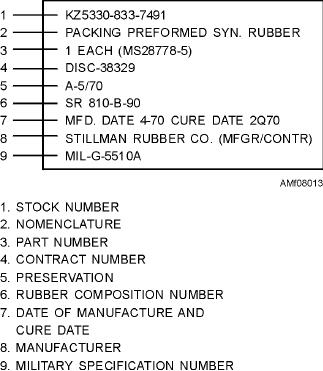
Age limitation of synthetic rubber O-rings is based
Identification
on the fact that the material deteriorates with age.
O-rings are manufactured according to military
O-ring age is computed from the cure date. The term
specifications and are identified from the technical
cure date is used in conjunction with replacement kits,
information printed on the O-ring package. See figure
which contain O-rings, parts, and hardware for shop
8-13. The size of O-rings cannot be positively identified
repair of various components. O-ring cure dates also
by visual examination without the use of special
provide bases for O-ring replacement schedules, which
equipment. For this reason, O-rings are made available
are determined by O-ring service life. The service life
in individual, hermetically sealed envelopes labeled
(estimated time of trouble-free service) of O-rings also
with all the necessary pertinent data.
depends upon such conditions as use, exposure to
certain elements, both natural and imposed, and
NOTE: Colored dots, dashes, and stripes or
subjection to physical stress. Operational conditions
combinations of dots and dashes on the surface of the
imposed on O-rings in one component may necessitate
O-ring are no longer used for identification of O-rings.
O-ring replacement more frequently than replacement
O-rings still found with these color identification
of identical O-rings in other components. It is necessary
markings are NOT to be used in naval aircraft hydraulic
to adhere to the recommended replacement schedule
systems or components and should be depleted from
for each individual component. The age of O-rings in a
stock.
spare part is determined from the assembly date
Figure 8-13 shows the information printed on an
recorded on the service or identification plate and/or on
O-ring package that is essential to determine the
the exterior of the container. All O-rings over 24
intended use, qualifications, and age limitations. The
months old should be replaced or, if nearing their age
manufacturer's cure date is one of the more important
limit (24 months), should not be used for replacement.
printed items listed on the package. This cure date is
denoted in quarters. For example, the cure date 2Q82
Storage
indicates that the O-ring was manufactured during the
Proper storage practices must be observed to
second quarter of 1982. Synthetic rubber parts
prevent deformation and deterioration of rubber
manufactured during any given quarter are not
O-rings. Most synthetic rubbers are not damaged by
considered one quarter old until the end of the
several years of storage under ideal conditions.
succeeding quarter. Most O-ring age limitation is
However, most synthetic rubbers deteriorate when
determined by this cure date, anticipated service life,
exposed to heat, light, oil, grease, fuels, solvents,
and replacement schedule.
thinners, moisture, strong drafts, or ozone (form of
oxygen formed from an electrical discharge). Damage
by exposure is magnified when rubber is under tension,
compression, or stress.
There are several conditions to be avoided, which
include the following:
Deformation as a result of improper stacking of
parts and storage containers
Creasing caused by a force applied to corners
and edges, and by squeezing between boxes and
storage containers
Compression and flattening, as a result of
storage under heavy parts
Punctures caused by staples used to attach
identification
Deformation and contamination due to hanging
the O-rings from nails or pegs
Figure 8-13.--O-ring package identification.
8-24

